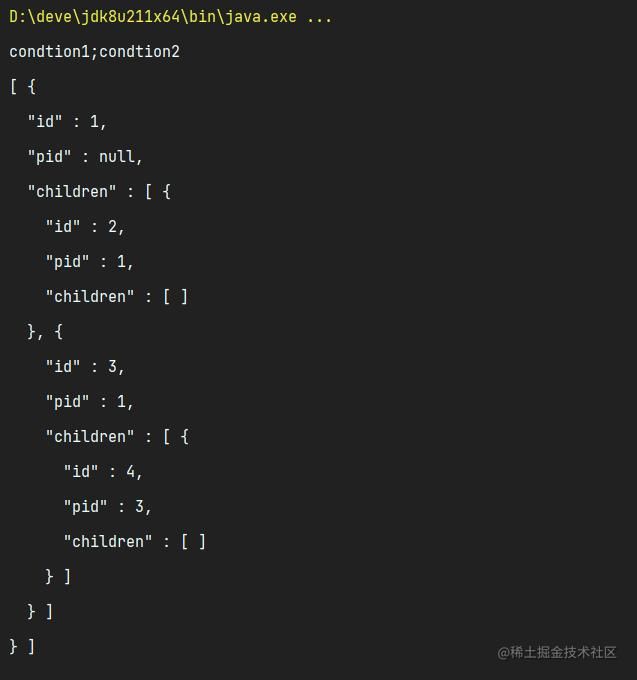很多时候为满足前后端交互的数据结构需求,往往我们需要把平铺的
List数据与Tree型层级数据结构进行互转,这篇文章提供详实的递归和非递归的方式去实现数据结构转换,为了使用到lambda的特性,Java version >=8。
需求
我们从基础设施层获取了一个列表数据,列表其中的对象结构如下,注意约束条件如果没有pid,默认为null。
@Getter
@Setter
@ToString
@Builder
public class NodeEntity {
/**
* id
*/
private Long id;
/**
* 父id
*/
private Long pid;
}
现在我们要将List 数据,按照属性pid进行Tree型层级封装,并且支持多层级封装。一般很容易想到递归的实现方法,接下来这篇文章使用一套通用的解决办法,非递归实现结构转换。
实践List to Tree
递归实现
首先定义通用的Tree形数据接口。
public interface INodeDTO {
/**
* id
* @return id
*/
public Long getId();
/**
* pid
* @return pid
*/
public Long getPid();
/**
* 获取Children
* @return Children
*/
public List getChildren();
/**
* 设置children
* @param children children
*/
public void setChildren(List children);
}
每个方法接口有详细的注释,无需多说。然后提供通用的转换Function。
/**
* 非递归实现平铺数据转成Tree型结构
*/
static final Function,List> MULTI_TREE_CONVERTER = sources->
sources.stream()
.filter(item->{
item.setChildren(
sources.stream()
.filter(e-> Objects.equals(e.getPid(), item.getId()))
.collect(Collectors.toList()));
return item.getPid() == null;})
.collect(Collectors.toList());
我们利用对象引用,浅拷贝的原理,通过循环查找来组装层级,最后根据pid==null的数据一定是Tree型第一层的数据的条件进行过滤,筛选出第一层的数据组合成新的列表,达到目的。
非递归实现
//Establish tree structure static ListbuildTree (List sources){ List results = new ArrayList<>(); //get root nodes List rootNodes = sources.stream().filter(x->x.getPid() == null).collect(Collectors.toList()); for (INodeDTO rootNode : rootNodes) { results.add(buildChildTree(sources,rootNode)); } return results; } //Recursion, building subtree structure static INodeDTO buildChildTree(List sources,INodeDTO pNode){ List children = new ArrayList<>(); for (INodeDTO source : sources) { if(source.getPid()!=null && source.getPid().equals(pNode.getId())){ children.add(buildChildTree(sources,source)); } } pNode.setChildren(children); return pNode; }
递归的实现先获取所有根节点,方法builTree总结根节点来创建一个树结构,buildChilTree为节点构建一个辅助树,并拼接当前树,递归调用buildChilTree来不断打开当前树的分支和叶子,直到没有找到新的子树, 完成递归,得到树结构。
递归最大的问题可能堆栈太深,容易造成溢出,使用需要谨慎,而且从代码简洁度来说,肯定是使用了非递归的方式更好。
递归代码还能进一步优化,比如改成尾递归的方式,有兴趣的小伙伴可以尝试一下。
实例
实例只测试非递归实现方法。
那具体怎么使用呢?首先我们通过implements接口INodeDTO,实现我们自己的业务DTO。
@Getter
@Setter
@ToString
@Builder
public class NodeDTO implements INodeDTO {
private Long id;
private Long pid;
List children;
}
然后在我们Service层组装业务逻辑,这里提供一个listBy的条件查询接口,从基础设施层按照条件捞出List,期望转成内部包含层级关系的List。
public class UseCase {
public List listBy(String ... condtions){
System.out.println(Arrays.stream(condtions).reduce((a, b) -> a + ";" + b).orElse(""));
//TODO get NodeEntities from database
List entities = Arrays.asList(
NodeEntity.builder().id(1L).pid(null).build(),
NodeEntity.builder().id(2L).pid(1L).build(),
NodeEntity.builder().id(3L).pid(1L).build(),
NodeEntity.builder().id(4L).pid(3L).build()
);
List sources = entities.stream()
.map(Factory.NODE_DTO_BUILDER::apply)
.collect(Collectors.toList());
return INodeDTO.MULTI_TREE_CONVERTER.apply(sources);
}
}
提供一个main方法进行测试。
public static void main(String[] args) throws JsonProcessingException {
UseCase useCase = new UseCase();
List results = useCase.listBy("condtion1", "condtion2");
//convert json with style
ObjectMapper objectMapper = new ObjectMapper();
String json = objectMapper.writerWithDefaultPrettyPrinter().writeValueAsString(results);
System.out.println(json);
}
运行后输出结果如下,经人工肉眼检验,达到Tree型层级结构。
实践Tree to List
上面讲到了平铺列表(List)转树形(Tree)结构,一般来说对于足够后端数据转成前端想要的结构了。但都支持了正向转换,那么反向转换,即树形(Tree)结构如何转平铺列表(List)呢?
递归实现
递归实现,分为两个函数,List 接受外部调用,传入待转换的Tree形结构。第一步便是收集所有的根节点,然后将所有的根节点传入到递归函数List中深度遍历,最后汇总再使用distinct做去重处理得到最终的list结构。
/** * Flatten a Tree to a list using recursion(递归实现) * @param flatList flatList * @return list */ static Listflatten(List flatList){ return flatList.stream() .filter(x -> x.getPid() == null) .collect(Collectors.toList()) .stream() .map(x->{return flatten(x,flatList);}) .flatMap(Collection::stream) .distinct() .collect(Collectors.toList()); } /** * recursion * @param node root node * @param flatList flatList * @return list */ static List flatten(INodeDTO node, List flatList) { List results = new ArrayList<>(); if(node != null){ // get rid of children & parent references INodeDTO n = NodeDTO.builder() .pid(node.getPid()) .id(node.getId()) .build(); results.add(n); } List children = node.getChildren(); for (INodeDTO child : children) { if(child.getChildren() != null) { // Recursive call - Keep flattening until no more children List flatten = flatten(child, flatList); results.addAll(flatten); } } // stop or exit condition return results; }
非递归实现
在非递归,即循环的实现中,我们要用到dequeue数据结构。
deque表示一个双端队列,这意味着可以从队列的两端添加和删除元素。 deque的不同之处在于添加和删除条目的不受限制的特性。
在实现中,ArrayDeque将被用作LIFO(即后进先出)数据结构(即堆栈)。
/** * Flatten a Tree to a list using a while Loop instead of recursion * @param flatList flatList * @return list */ static Listflatten2(List flatList){ return flatList.stream() .filter(x -> x.getPid() == null) .collect(Collectors.toList()) .stream() .map(TreeToMapUtils::flatten2) .flatMap(Collection::stream) .distinct() .collect(Collectors.toList()); } /** * . Flatten using a Deque - Double ended Queue * **/ static List flatten2(INodeDTO node) { if (node == null) { return null; } List flatList = new ArrayList<>(); Deque q = new ArrayDeque<>(); //add the root q.addLast(node); //Keep looping until all nodes are traversed while (!q.isEmpty()) { INodeDTO n = q.removeLast(); flatList.add(NodeDTO.builder().id(n.getId()).pid(n.getPid()).build()); List children = n.getChildren(); if (children != null) { for (INodeDTO child : children) { q.addLast(child); } } } return flatList; }
实例
在实例中,我们主要用到list to map 中的输出,看是否能用flatten函数还原结构。
public static void main(String[] args) throws JsonProcessingException {
UseCase useCase = new UseCase();
List results = useCase.listBy("condtion1", "condtion2");
//convert json with style1 = {NodeDTO@1502} "NodeDTO(id=1, pid=null, children=null)"
ObjectMapper objectMapper = new ObjectMapper();
String json = objectMapper.writerWithDefaultPrettyPrinter().writeValueAsString(results);
System.out.println(json);
//flatten now
List flatten = TreeToMapUtils.flatten2(results);
System.out.println(flatten);
}
输出结果不但包含Tree形数据结构,还获取到了list数据,如下图所示,至此,达到效果。
![]()
总结
至此,递归和非递归分别实现list to tree 和tree to list已完成,实现比较仓促,有很多细节处未处理好,希望看到的小伙伴及时指出,不胜感激。
到此这篇关于Java实现平铺列表(List)互转树形(Tree)结构的文章就介绍到这了,更多相关Java List转树形Tree结构内容请搜索脚本之家以前的文章或继续浏览下面的相关文章希望大家以后多多支持脚本之家!
